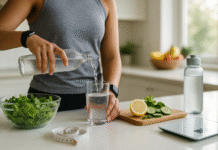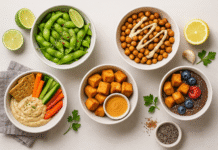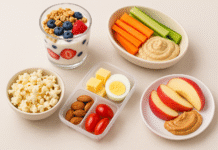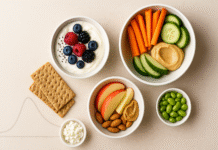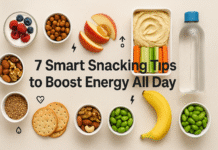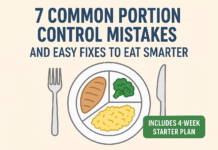If you’ve ever felt defeated by endless dieting rules or overwhelmed by calorie counting, the 30-Day Portion Control Challenge offers a clear, science-backed pathway to smarter eating without deprivation. In the next 30 days you’ll learn how to size your plate, use simple tools (your hands, a plate, basic kitchen items), build habits that stick, and measure progress in realistic ways. This guide is written for busy adults who want a practical program to reduce overeating, improve meal balance, and build sustainable habits — whether your goal is weight loss, improved energy, or simply eating more mindfully.
Medical disclaimer: This article provides general information and practical strategies. It is not medical advice. If you have existing health conditions (including diabetes, eating disorders, pregnancy, or are on prescription medications), consult a qualified health professional before starting any weight loss or portion-control program.
Key takeaways
- Small, consistent portion changes work. A modest daily calorie reduction (for most people) can produce steady, sustainable weight loss.
- Tools beat willpower. Plates, measuring utensils, and simple visual cues (hand, fist) make portion control easy and repeatable.
- Track to transform. Daily self-monitoring (meals, weight, photos) is one of the strongest predictors of success.
- 30 days jumpstarts habit-building. Expect meaningful behavior change, but plan beyond 30 days for lasting results.
- Safety first. Aim for gradual progress; rapid cuts in calories can backfire physiologically and psychologically.
Why portion control works (and why 30 days is a smart start)
What it is and core benefits or purpose.
Portion control is the practice of managing the amounts of different foods you eat at each meal and snack so that your total intake matches your goals and energy needs. Benefits include reduced inadvertent calorie intake, better blood sugar responses, improved digestion and satiety, and long-term habit change that supports weight and health goals.
Requirements/prerequisites and low-cost alternatives.
You need three simple things to begin: a regular plate or bowl, a basic kitchen scale or measuring cups (optional), and a willingness to record what you eat. Low-cost alternatives: use your hand as a measuring tool, use a standard dinner plate (not a platter), and take quick meal photos with your phone instead of logging detailed entries.
Step-by-step instructions (beginner friendly).
- Start each meal by using a plate you can see the edges of (not a large platter).
- Fill half the plate with vegetables/non-starchy salad or fruit.
- Divide the remaining half: one quarter lean protein, one quarter whole grains or starchy veg.
- Add a small separate portion for fats (1–2 tbsp oil, avocado, or nut butter).
- Sip water before eating and pause halfway through to check fullness.
Beginner modifications and progressions.
- Modify: If you’re new to measuring, begin with the plate method and the hand-portions (palm for protein, fist for carbs) rather than cups or scales.
- Progress: After 1–2 weeks, start weighing high-calorie foods (oils, nuts) or tracking calories for 2–3 meals weekly to refine estimates.
Recommended frequency/duration/metrics.
- Use portion-control at every main meal (breakfast, lunch, dinner) for best results.
- Track one objective metric: daily body weight (same time, same scale), and one behavior metric: number of meals sized correctly per day.
- Expect measurable changes in appetite and meal composition within 7–14 days; weight changes are typically visible in 2–4 weeks.
Safety, caveats, and common mistakes.
- Caveat: Portion control is not the same as extreme calorie restriction. Avoid eating below medically recommended minimums.
- Common mistakes: using oversized plates, ignoring liquids (calories in drinks), and “compensating” later in the day by skipping meals (which often backfires).
Sample mini-plan (2–3 steps).
- Day 1–3: Practice the plate method at dinner only.
- Day 4–7: Apply the plate method at two meals daily; take a photo of each plate.
- Week 2: Add a daily 30-second portion check routine (scan plate, adjust).
Tools you need and easy, budget-friendly alternatives
What it is and core benefits or purpose.
A small set of tools makes portion control automatic: a 9-inch plate, measuring cups/spoons, digital kitchen scale, clear containers, and a simple log (paper or phone). Tools reduce guesswork and increase consistency.
Requirements/prerequisites and low-cost alternatives.
- Nice-to-have: digital scale, 1-cup and ½-cup measures, 9-inch plate, shallow bowls.
- Low-cost alternative: use your phone camera for meal photos, use a coffee mug (~1 cup) and your hand for protein measures (palm = ~3 oz).
Step-by-step instructions.
- Identify one meal per day to master with tools (start with dinner).
- Measure or estimate portions for that meal using the plate method and either measuring cups or hand cues.
- Record the meal (photo + brief note) in a notebook or app.
Beginner modifications and progressions.
- Start without a scale: use fist/palm visual cues.
- Progress to weighing portions once per week to calibrate your eye.
Recommended frequency/duration/metrics.
- Use tools every meal for 30 days to build the visual memory.
- Metric: number of measured meals per week.
Safety, caveats, and mistakes.
- Mistake: obsessively measuring every crumb. Use measurement to learn, not to induce anxiety.
- Caveat: measurement may be impractical for social meals; learn to approximate.
Sample mini-plan (2–3 steps).
- Buy or borrow a kitchen scale.
- Measure a familiar meal (e.g., chicken + rice + veg) once to learn true portions.
- For the next seven days, replicate that plate by eye.
The plate and hand methods: practical how-to and benefits
What it is and core benefits or purpose.
Two visual systems that make portioning intuitive. The plate method divides your dish visually; the hand method uses your own hand as a measuring tool. Both are portable, reliable, and require no apps.
Requirements/prerequisites and low-cost alternatives.
- Plate method requires a plate; hand method requires only your hands — perfect when eating out or traveling.
Step-by-step instructions (plate method).
- Use a regular-sized plate.
- Fill half with non-starchy vegetables or salad.
- Reserve one quarter for lean protein.
- Reserve one quarter for whole grains/starchy veg.
- Add a small portion of healthy fat separately.
Step-by-step instructions (hand method).
- Palm = protein serving (~3–4 oz cooked).
- Fist = carbohydrate serving (~1 cup cooked).
- Thumb = healthy fat (~1 tbsp).
- Two cupped hands = vegetables/greens (~2 cups raw).
Beginner modifications and progressions.
- Modify: Use a bowl instead of a plate—divide it into similar visual quarters.
- Progress: Combine plate/hand methods with occasional weighing to fine-tune portions.
Recommended frequency/duration/metrics.
- Use these methods at every meal for the 30-day challenge.
- Track compliance: percent of meals where you used the method.
Safety, caveats, and mistakes.
- Mistake: assuming “small plate = small calories” when the food is calorie-dense (nuts, oils).
- Caveat: hand sizes vary; use your hand as a relative personal gauge, not an absolute measure.
Sample mini-plan (2–3 steps).
- Practice the plate method at dinner for a week.
- Switch to the hand method for lunches when you’re away from kitchen tools.
- At the end of week two, compare photos to see consistency.
Daily habits and behavior change: designing 30 days you’ll actually finish
What it is and core benefits or purpose.
Habits are repeated behaviors that become easier over time. A focused 30-day challenge gives structure to repeated, measurable actions (e.g., “use the plate method at dinner every day”).
Requirements/prerequisites and low-cost alternatives.
- You need simple cues (alarm or calendar), a clear plan, and a tracking method. Alternatives: sticky notes on the fridge, a checklist app, or a paper calendar.
Step-by-step instructions (habit stacking & cues).
- Pick a daily anchor (something you already do — brush teeth, make coffee).
- “Stack” the new action onto the anchor: e.g., “After I pour my morning coffee, I will pack my lunch using the plate method.”
- Track completion each day.
Beginner modifications and progressions.
- Modify: start with one target meal per day.
- Progress: after week two add mindful eating cues (put fork down between bites, chew thoroughly).
Recommended frequency/duration/metrics.
- Do the new behavior daily for at least 30 days.
- Metric: consistency percentage (days completed / 30).
Safety, caveats, and mistakes.
- Mistake: changing too many things at once. Focus on one habit until it’s automatic.
- Caveat: average habit formation time varies widely; 30 days is a strong start but not guaranteed to create lifelong automaticity.
Sample mini-plan (2–3 steps).
- Week 1: pick an anchor and perform one portion-controlled meal daily.
- Week 2: expand to two meals daily and add a pre-meal water sip.
- Week 3–4: add a weekly review and adjust portions.
The 30-day challenge: daily structure and weekly goals
What it is and core benefits or purpose.
A structured, progressive plan that builds portion-control skills and self-monitoring in manageable steps over four weeks.
Requirements/prerequisites and low-cost alternatives.
- Requirement: calendar or printed planner, a phone camera, and either a notebook or a tracking app. Alternatives: paper checklist and envelope for receipts if you don’t track digitally.
Step-by-step implementation (daily rhythm).
- Daily (every day): Use plate/hand method for at least one main meal; drink a glass of water before the meal; take a photo of one meal.
- Weekly: Weigh once per week at the same time and place; review your log and identify one adjustment.
- End of challenge: Summarize wins, pain points, and set a follow-up 30-day goal.
Beginner modifications and progressions.
- Start with dinners only for week one.
- Progress to two meals/day in week two, and three meals/day by week three if comfortable.
Recommended frequency/duration/metrics.
- Frequency: daily for practice; formal weigh-in weekly.
- Metrics: meals portioned correctly (target 75% of meals by week 4), weekly weight change, hunger ratings before and after meals.
Safety, caveats, and mistakes.
- Mistake: daily scale obsession — weigh weekly and look for trends over days.
- Caveat: weight fluctuates due to hydration and glycogen; focus on behavior metrics first.
Sample mini-plan (2–3 steps).
- Day 1–7: master dinner portioning and take nightly photo.
- Day 8–14: add portioning to lunch and keep photos.
- Day 15–30: maintain all main meals, refine snacks and beverages.
Measuring progress: the smart metrics you should use
What it is and core benefits or purpose.
Progress is more than the scale. Combine weight, behavior tracking, and objective measures (waist circumference, photos) for a comprehensive view.
Requirements/prerequisites and alternatives.
- Scales, measuring tape, camera, simple log. Alternative: clothing fit and energy levels.
Step-by-step measurement protocol.
- Weigh once weekly (first morning after waking and voiding).
- Measure waist at the navel once every two weeks.
- Take weekly plate/photos to visually compare.
- Record how many meals used the plate/hand method each day.
Beginner modifications and progressions.
- If scales cause anxiety, use clothing fit and weekly photos instead.
- Progress to tracking macronutrient balance only if you want more precision.
Recommended frequency/duration/metrics.
- Weigh weekly, photos weekly, portions logged daily.
- Metrics to watch: weekly change (0.5–1 kg per week is a reasonable safe range for many); percent of meals portioned correctly.
Safety, caveats, and mistakes.
- Mistake: reading too much into one bad day. Use weekly averages.
- Caveat: certain medications and health conditions influence weight; be mindful.
Sample mini-plan (2–3 steps).
- Choose a consistent weigh-in day (e.g., Saturday morning).
- Measure waist every two weeks and save measurements.
- Compare week 1 photos to week 4 photos for non-scale wins.
Troubleshooting and common pitfalls (and how to fix them)
What it is and core benefits or purpose.
Common problems like hunger, social eating, inaccurate portions, and plate overload are fixable with targeted strategies.
Requirements/prerequisites and alternatives.
- Awareness of triggers (stress, boredom), and a few prepared responses (snack swaps, boundary phrases for social meals).
Step-by-step troubleshooting for top problems.
- Problem: Still hungry after meal.
- Add non-starchy vegetables or a cup of broth-based soup.
- Check protein and fiber — increase protein by one palm-sized portion, add beans or lentils.
- Wait 10–15 minutes; fullness signals take time.
- Problem: Portion creep at restaurants.
- Ask for a half portion or split a main with a friend.
- Immediately box half the meal to remove temptation.
- Problem: Liquid calories sabotage progress.
- Replace sugary drinks with water or unsweetened tea.
- If you drink coffee with sugar or syrups, reduce add-ins gradually.
Beginner modifications and progressions.
- Modify: if hunger is persistent, slightly increase portions of vegetables and lean proteins rather than carbs.
- Progress: refine meal timing and add structured snacks to prevent overeating.
Recommended frequency/duration/metrics.
- Apply fixes immediately when a pattern emerges; track whether the fix reduces the problem within 7–10 days.
Safety, caveats, and mistakes.
- Mistake: cutting too many calories in response to a plateau. Plateaus are normal—review behaviors, not panic.
- Caveat: persistent hunger despite reasonable portions may signal a medical issue—consult a professional.
Sample mini-plan (2–3 steps).
- Identify the toughest trigger (e.g., evening snack).
- Implement one strategy (replace with a protein-rich snack) for seven nights.
- Reassess and tweak.
Beginner modifications and progressions (how to scale this program)
What it is and core benefits or purpose.
Everyone starts in a different place. Scaling allows the program to match time, culinary skills, and goals.
Requirements/prerequisites and alternatives.
- A baseline: are you sedentary or active? Do you cook? Use this to choose modifications.
Step-by-step scaling plan.
- For absolute beginners: focus on one meal per day, plate method only, photos only.
- For intermediate users: add two meals/day, measure a couple of commonly overeaten foods (nuts, cheese), log calories 2–3 times/week.
- For advanced users: combine portion control with meal prep, macro tracking, and resistance training for body composition goals.
Beginner modifications and progressions.
- Modify: Busy days? Use portion-control containers or pre-portioned snacks.
- Progress: After month one, aim to reduce one portion of refined carbs per day and replace with extra veggies or protein.
Recommended frequency/duration/metrics.
- Move from 1 meal/day → 2 meals/day → all meals across a 4–8 week window.
- Metrics: consistency and subjective energy/fullness ratings.
Safety, caveats, and mistakes.
- Mistake: expecting immediate perfect adherence. Aim for incremental improvement.
- Caveat: increased activity requires more fuel; don’t under-eat.
Sample mini-plan (2–3 steps).
- Week 1: one meal/day, plate method.
- Week 2–3: two meals/day + photos.
- Week 4: all main meals portioned, weekly weigh-in.
A simple 4-week starter plan (daily and weekly actions)
Below is a practical, flexible roadmap you can follow or adapt.
Week 1 — Foundation
- Goal: learn visual cues; practice plate method at dinner every day.
- Daily: drink 1 glass of water 15 minutes before dinner; use plate method; photograph dinner.
- Weekly: weigh on day 7, note how you felt, and identify one challenge.
Week 2 — Build consistency
- Goal: extend to lunch; introduce hand method for portability.
- Daily: plate method at lunch and dinner; use hand cues for any meals out.
- Weekly: weigh on day 14; measure waist; schedule 15 minutes for meal prep.
Week 3 — Tighten the details
- Goal: refine snacks and beverages; reduce liquid calories.
- Daily: replace one sugary drink with water; portion snacks in single-serve bags; continue plate/hand at all main meals.
- Weekly: weigh on day 21; compare photos to week 1.
Week 4 — Make it yours
- Goal: fine-tune and plan next steps.
- Daily: prepare 2 portion-controlled meals ahead of time; practice mindful eating (put fork down between bites).
- Weekly: weigh on day 28; write a short reflection and set an ongoing 30-day plan.
Mini daily checklist (quick-start)
- Drink a glass of water before each main meal.
- Use plate or hand method for at least one main meal.
- Take one plate photo.
- Remove high-calorie liquids and limit snacks to pre-measured portions.
- Note one win in your log.
Safety, special populations, and caveats
What it is and core benefits or purpose.
Portion control is broadly safe but must be individualized. Certain groups need tailored planning: people with diabetes, pregnant or breastfeeding people, those with eating disorders, older adults, and people on medications that affect appetite or weight.
Requirements/prerequisites and alternatives.
- If you fall into any special category, consult a qualified health professional before major changes.
- Alternatives: work with a registered dietitian for tailored portions, or use supervised programs where needed.
Step-by-step precautions.
- If you have diabetes, discuss carbohydrate portioning with your clinician.
- If you’re pregnant or breastfeeding, avoid deliberate calorie restriction unless advised.
- If you have a history of disordered eating, use a professional-supported plan.
Beginner modifications and progressions.
- Modify for older adults: ensure sufficient protein to preserve muscle; prioritize nutrient-dense choices.
- Progress: if medically cleared, add strength training to preserve lean mass.
Recommended frequency/duration/metrics.
- Medical review before starting if you’re on medications that affect appetite/weight.
- Metric: check-in with clinician if progress is unusually fast or symptoms appear.
Safety, caveats, and mistakes.
- Mistake: treating portion control as punishment rather than a skill-building tool.
- Caveat: very low-calorie diets without medical supervision can lead to nutrient deficiencies and metabolic issues.
Sample mini-plan (2–3 steps).
- Ask your clinician whether a 500-calorie daily deficit is safe for you.
- If cleared, start with gentle changes (plate method) and monitor energy and sleep.
- Reassess with a professional if you experience excessive fatigue, dizziness, or mood changes.
Evidence & what research says (plain summary)
- Moderate, steady calorie reduction tends to be more sustainable and safer than rapid weight loss.
- Creating a daily calorie deficit of roughly 500 calories is a commonly used target for gradual weight loss.
- Visual tools like the plate method and hand-portions are practical and effective for helping people reduce portions without constant measuring.
- Self-monitoring (food logs, photos, weigh-ins) is strongly associated with better outcomes in short-term interventions.
- Habit formation varies by individual; while 30 days is a good kickstart, habit automaticity often requires longer and steady repetition.
These conclusions are reflected in multiple public health and clinical resources and short-term intervention studies.
Troubleshooting: Quick fixes for five sticky situations
- Evening overeating: Make dinner more filling with extra vegetables and a palm-sized protein. Delay dessert by 15 minutes; if still hungry, have it — otherwise skip.
- Workday stress snacking: Keep pre-portioned healthier snacks at your desk and schedule short movement breaks.
- Social eating out: Scan the menu early, choose shared plates, or order a starter as your main and box the rest.
- Hidden calories from drinks: Replace sugary drinks with sparkling water + lemon or unsweetened tea.
- Plate misperception: Use a 9-inch plate or draw quarter lines with a fork to practice visual segmentation.
Frequently Asked Questions (8–12)
1. Will I lose weight in 30 days with portion control?
Many people see measurable weight changes in 2–4 weeks when portion control reduces daily calories. Results vary by starting weight, activity level, and adherence.
2. How much should I reduce my calories?
A commonly used target for many adults is about 500 calories less per day to aim for roughly 1 pound (≈0.45 kg) weight loss per week, but individual needs differ. Avoid dropping below medically recommended minimums.
3. Can I still enjoy treats?
Yes. Portion control is about frequency and size. Pre-portion your treat to satisfy cravings without derailing progress.
4. What if I feel constantly hungry?
Increase fiber and lean protein, drink water before meals, and ensure you’re not under-eating relative to activity level. If hunger persists, consult a clinician.
5. Is counting calories necessary?
Not for everyone. Visual systems (plate/hand methods) work well for many. Counting can be a useful short-term calibration tool.
6. How do I handle social gatherings?
Eat a small but balanced snack before events, choose smaller plates, and don’t feel compelled to finish everything. Offer to bring a healthy dish.
7. Will portion control help with blood sugar control?
Yes—balanced portions, especially consistent carbohydrate portions, help stabilize blood sugar. If you have diabetes, coordinate with your care team.
8. What metrics should I track?
Weekly weigh-ins, waist measurements every 2–4 weeks, and daily behavioral tracking (meals portioned, meal photos).
9. Can portion control preserve muscle mass?
To better preserve muscle while losing fat, keep protein intake reasonable and include resistance training.
10. How do I avoid plateaus?
Plateaus are normal. Reassess portions, protein intake, activity, sleep, and stress. Small sustainable adjustments beat drastic changes.
11. What if I have a history of disordered eating?
Portion-focused programs can trigger stress for some people. Seek personalized guidance from a qualified health professional.
12. After 30 days, what next?
Use the momentum to set a new 30-day goal (e.g., add strength training, refine portions, or maintain your new habits). Habit maintenance is the long game.
Final motivating conclusion
The 30-Day Portion Control Challenge isn’t a quick fix — it’s a practical, teachable skillset that removes guessing and replaces it with simple, repeatable choices. In 30 days you can build clarity about how much you actually eat, gain control over common triggers, and begin a ripple effect of healthier decisions that last. Keep it simple, track what matters, and be patient with the process — small, steady changes add up.
Ready to start? Take your first step today: choose one meal and apply the plate method.
References
- Food Portions: Choosing Just Enough for You, National Institute of Diabetes and Digestive and Kidney Diseases (NIDDK), 2025. https://www.niddk.nih.gov/health-information/weight-management/just-enough-food-portions
- Obesity — Treatment, NHS, last updated 2017 (page periodically updated). https://www.nhs.uk/conditions/obesity/treatment/
- 10 ways to cut 500 calories a day, MedlinePlus (U.S. National Library of Medicine), 2024. https://medlineplus.gov/ency/patientinstructions/000892.htm
- Steps for Losing Weight, Centers for Disease Control and Prevention (CDC), 2024. https://www.cdc.gov/healthy-weight/losing_weight/index.html
- Portion control for weight loss, Mayo Clinic, 2024. https://www.mayoclinic.org/healthy-lifestyle/weight-loss/in-depth/portion-control/art-20546800
- What Is MyPlate?, U.S. Department of Agriculture (MyPlate.gov), 2025. https://www.myplate.gov/eat-healthy/what-is-myplate
- Hand Portion FAQ: A Guide from Precision Nutrition, Precision Nutrition, 2021. https://www.precisionnutrition.com/hand-portion-faq
- Making health habitual: the psychology of ‘habit-formation’ and related research, British Psychological Society review and UCL reporting on habit formation (Phillippa Lally et al.), 2009. https://www.ucl.ac.uk/news/2009/aug/how-long-does-it-take-form-habit and https://pmc.ncbi.nlm.nih.gov/articles/PMC3505409/
- The Effect of Adherence to Dietary Tracking on Weight Loss, Journal article on dietary self-monitoring and apps (PMC), 2017. https://pmc.ncbi.nlm.nih.gov/articles/PMC5568610/
- The Use of Portion Control Plates to Promote Healthy Eating and Weight Management, peer-reviewed article (PMC), 2022. https://pmc.ncbi.nlm.nih.gov/articles/PMC8874720/
- Handy Guide to Serving Sizes (PDF), San Francisco State University / adapted from EatRight Ontario, 2018. https://wellness.sfsu.edu/sites/default/files/documents/Serving%20Size%20Hand%20Guide%20Condensed.pdf
- Healthy Eating Plate, Harvard T.H. Chan School of Public Health — The Nutrition Source, 2013. https://nutritionsource.hsph.harvard.edu/healthy-eating-plate/






























